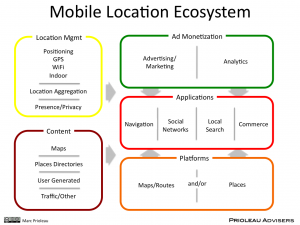Michael Vakulenko writes an interesting post on the gap in mobile services between the handset OEM’s and the big Internet Platforms such as Google and Microsoft. This has been pretty widely known but he does a nice job of outlining where the gaps are by competitor (see chart below).
Continue reading Filling the Gap

 In the previous post, I speculated that, despite the current infatuation with Pull-style location based apps, ultimately Push-based apps will have more appeal to enterprises wanting to connect with their customer base. My premise is that they won’t have a choice. While they may experiment with games, check-ins or what ever comes next, ultimately they will want to leverage their rich CRM data and they will want to own the customer connection. Working through a third party app won’t give them that. Developing their own app won’t get mind share. So they will look at ways to talk directly to the customer at the time and place of their choosing. And that will be through push.
In the previous post, I speculated that, despite the current infatuation with Pull-style location based apps, ultimately Push-based apps will have more appeal to enterprises wanting to connect with their customer base. My premise is that they won’t have a choice. While they may experiment with games, check-ins or what ever comes next, ultimately they will want to leverage their rich CRM data and they will want to own the customer connection. Working through a third party app won’t give them that. Developing their own app won’t get mind share. So they will look at ways to talk directly to the customer at the time and place of their choosing. And that will be through push. Marissa Mayer, head of Google Local gave a generally neglected overview of Google Maps at SXSW. She
Marissa Mayer, head of Google Local gave a generally neglected overview of Google Maps at SXSW. She 
 I believe that all mobile strategies will soon have a location component. When that happens, “location” appended to “mobile” will become redundant, like saying an electric computer.
I believe that all mobile strategies will soon have a location component. When that happens, “location” appended to “mobile” will become redundant, like saying an electric computer. (Note: Originally published on 7/28/10 at http://marcprioleau.blogspot.com/)
(Note: Originally published on 7/28/10 at http://marcprioleau.blogspot.com/)